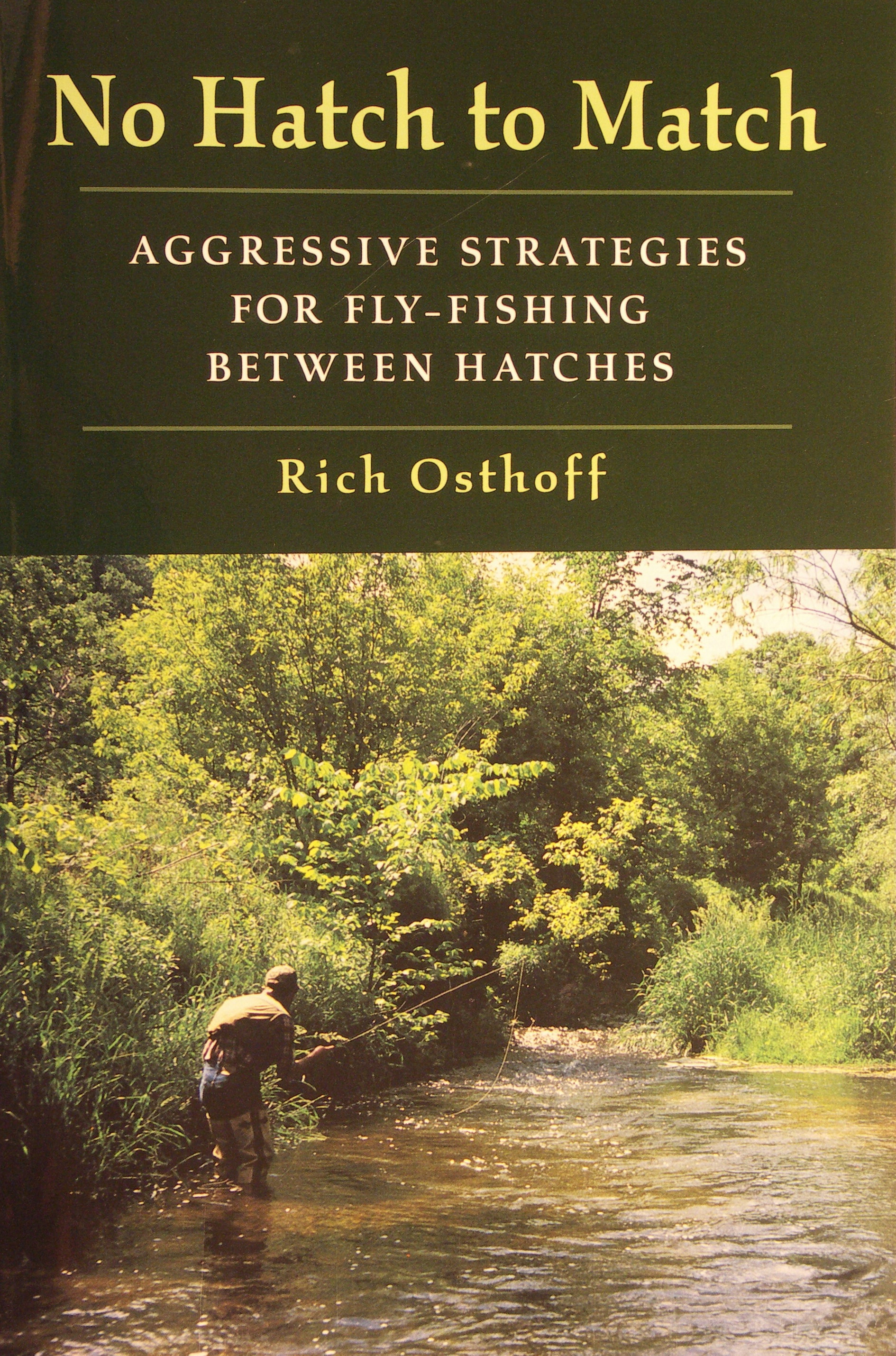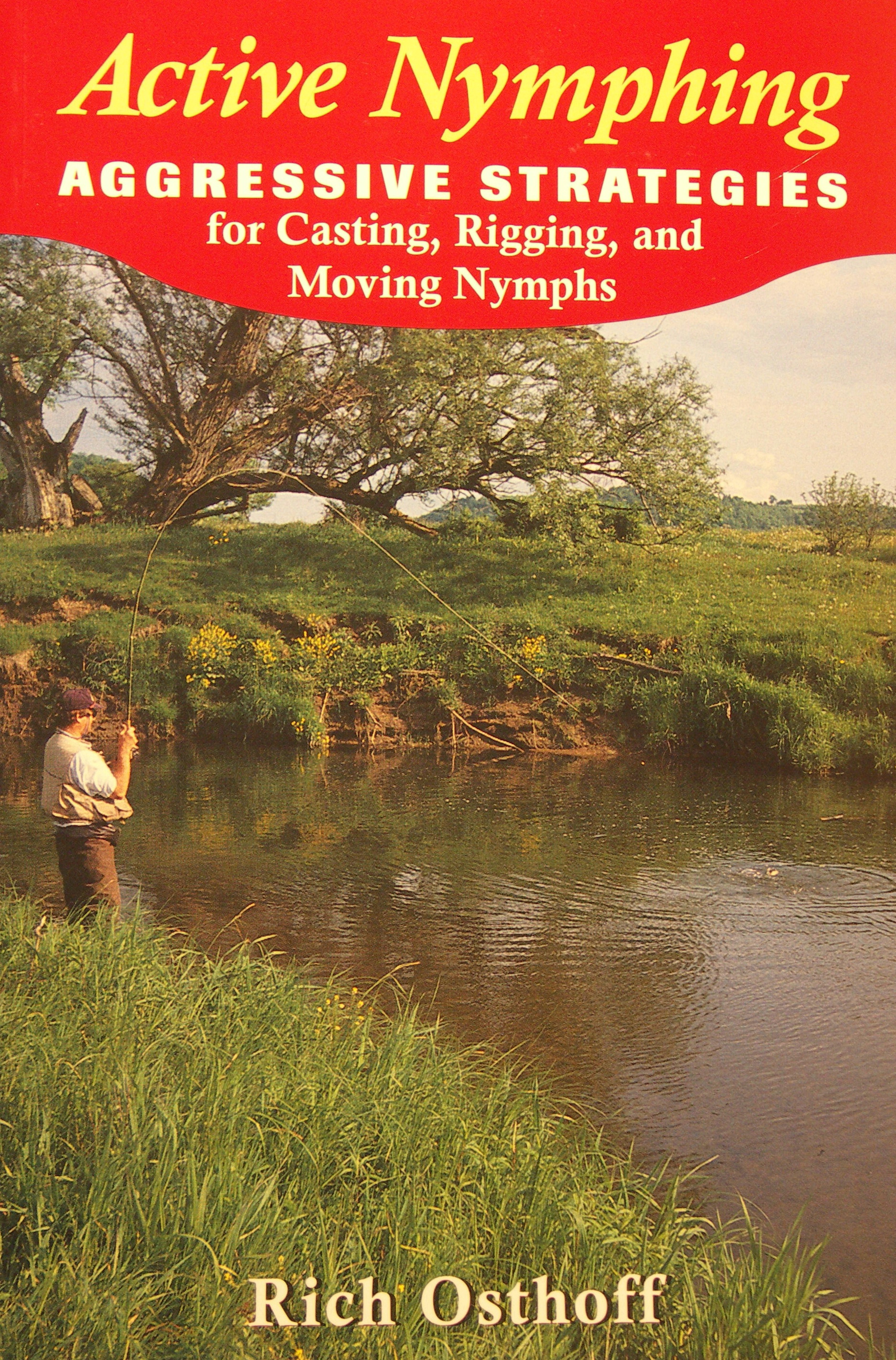|
  
***Fly-Fishing Books***
by Rich Osthoff
Order Signed Books Directly From the Author
Active Nymphing Aggressive Strategies for Rigging, Casting, and Moving Nymphs…$19.95
No Hatch to Match Aggressive Strategies for Fly-Fishing Between Hatches…$19.95
Fly-Fishing the Rocky Mountain Backcountry…$19.95
Apply a 15% Discount when you buy two or more books
(any combination of titles)
Book Ordering and Shipping Information
*Add $6.50 for shipping (no additional charge for shipping multiple books).
*Book orders are generally shipped within 1-2 days from receipt of order.
*U.S. orders travel by insured Priority Mail, which generally arrives in 2-3 days.
*For shipments within Wisconsin, add 5.5% sales tax.
NOTE: Books can also be shipped along with fly orders for a single $6.50 shipping charge (see the Fly Order Form on this website). When books and flies are ordered together, books are shipped along with flies as soon as your fly order is completed (unless you specify that you want books shipped immediately and pay a separate shipping charge).
Mail your book order, along with check or money order payable to Rich Osthoff, to:
Rich Osthoff
N6868 Sandstone Drive
Mauston, WI 53948
Phone (608) 847-5192
NOTE: If you’d like books signed for specific individuals, please specify their name(s) when ordering.
NEW!
(published January 2006, by Stackpole books)
Active Nymphing
Aggressive Strategies for Rigging, Casting, and Moving Nymphs
by Rich Osthoff
Color Photography * Drawings by Dave Hall * 200 pages * Softbound
Active Nymphing challenges the prevailing notion that nymphing entails little more than lobbing a weighted nymph and dead drifting with the current. Even heavily-weighted nymphs can be cast at high line speeds with near dry-fly accuracy out to surprising distances. And manipulating the nymph during part or all of the ‘drift’, puts the angler in precise manual control of its speed, path, and behavior. Active Nymphing will open your eyes to the many advantages of moving nymphs, rather than dead-drifting too dogmatically, and will help take your nymphing for trout to new levels on all water types, from spring creeks, to tailwaters, to freestone rivers, to lakes.
From the Text:
Forget everything you’ve heard about lobbing weighted nymphs…Delivering a weighted payload with near dry-fly accuracy requires significant line speed…
Moving a substantial nymph can touch off various forms of aggression—predatory, territorial, competitive, reflexive, or opportunistic—even in trout that are inactive and not particularly interested in feeding.
Ultimately, it is moving the nymph on a tight line, not dead drifting on a slack line, that gives you precise control over the speed and path of the nymph.
All kinds of matter, the bulk of it indigestible to trout, drifts with the current. But by and large, only living organisms move even slightly counter to the drift. Movement denotes life and grabs the attention of predatory trout. In true prospecting—when you’re just searching the water for opportunistic trout—that’s an awfully big card to play.
Chapter 1. Rigging, covers the most productive and versatile options for weighting nymphs and tippets, building nymphing leaders, and more.
Chapter 2. Casting Weighted Rigs will have you zinging even large nymphs on long lines with near dry-fly accuracy, as it takes you through the fundamentals and fine points of casting weighted payloads. Covers hauling, tucking, curve casts, aerial mends, and more.
Chapter 3. Reasons to Move the Nymph examines the many compelling reasons to fish nymphs actively, including: Agitating inactive trout. Accelerating your prospecting pace. Prospecting slow-water zones efficiently. Moving the nymph cross current to slow its downstream progression in fast or dirty water. Grabbing the attention of predatory trout from a wide radius and moving them to the nymph. Activating nymph materials. Enhanced strike detection. Overweighting for fast, vertical drops into productive zones and then moving the nymph to prevent hang-ups. Using controlled drag. Using heavier tippets. Precise steering and manipulation. And more.
Chapter 4. Downstream Strategies. In some conditions and water types, nymphing downstream is far more productive than working upstream. Learn when and how to nymph downstream with remarkable efficiency.
Chapter 5. Long-line Nymphing brings the visual excitement of dry-fly fishing to the nymphing game. In essence, it entails standing back and firing long, accurate casts to active trout that are patrolling specific feeding stations. When active trout have dispersed from deeper refuge water to relatively shallow feeding lies, no form of nymphing is more exciting or potent.
Chapter 6. Micronymphing is often the key to steady action between hatches on fertile spring creeks and tailwaters. It can even click while standing in plain view of pods of inactive trout.
Chapter 7. No-Line Nymphing covers unorthodox techniques for nymphing blind spots, riffles, and dirty water.
Chapter 8. Nymphing Lakes explores a range of innovative techniques for targeting stillwater trout.
Chapter 9. Designing Active Nymphs. Tying concepts and techniques for boosting the potency of your attractor and imitative nymphs.
No Hatch to Match
Aggressive Strategies For Fly-Fishing Between Hatches
by Rich Osthoff
(published 2001, by Stackpole books)
Color Photography * Drawings by Dave Hall * 150 pages * Softbound
“..thoughtful and worthwhile” –Steve Raymond, Fly Fisherman magazine
“Osthoff is charmingly enthusiastic and informative.” –Nelson Bryant, New york Times
“…buy it, read it and you won’t be disappointed.”--Wayne Bartz, Midwest Flyfishing
No Hatch to Match is a comprehensive look at fishing resourcefully between hatches—a surprisingly neglected subject, considering that, for most of us, it encompasses the bulk of our time on the water. Hey, hatches come and go, but it’s how we utilize the hours and days between hatches that largely governs our trout fishing enjoyment and success.
No Hatch to Match emphasizes seeing the big picture and choosing an effective strategy for the conditions at hand. Plus, it contains a wealth of technical detail for employing specific strategies. Lively reading loaded with insights to help you crack demanding trout waters from the Midwest to the Rockies.
From the Preface:
“Learning to fish well between hatches isn’t some angling side road. It’s main-street-stuff you’ll use every outing. It’s learning to deal with tough conditions from sweltering heat to dirty water. It’s mastering subtle techniques, such as micronymphing at close quarters for inactive trout, and aggressive techniques, like long-line nymphing with dry-fly precision for active trout. It’s anticipating temperature-induced feeding binges and understanding the seasonal factors that govern where in a watershed the bulk of the trout will be. It’s identifying niches of active trout and then covering water at a productive clip to exploit those niches. It’s having some parlor tricks up your sleeve and recognizing opportunities to use them.”
16 Chapters
Part One: Taking What the Water Will Give You
Chapter 1. Anticipating Temperature-Induced Feeding Binges
Chapter 2. Tracking Seasonal Trout Movement
Part Two: Prospecting Tactics and Flies
Chapter 3. Long-line Nymphing for Active Trout
Chapter 4. Micronymphing for Inactive Trout
Chapter 5. Streamer Tactics
Chapter 6. Prospecting with Dry Flies
Chapter 7. Some Top Prospecting Flies and What Makes Them Tick
Part Three: Special Situations
Chapter 8. Beating the Heat
Chapter 9. Dealing with Dirty Water
Chapter 10. Targeting Carnivorous Trout
Chapter 11. Probing Lunker Structures
Chapter 12. Parlor Tricks
Part Four: Building a Framework for Success
Chapter 13. Pacing: The Neglected Factor
Chapter 14. Escaping Tailwater Crowds
Chapter 15. Expanding Your Universe
Chapter 16. The Advantages of Fishing Solo
Fly-Fishing the Rocky Mountain Backcountry
by Rich Osthoff
(published 1999, by Stackpole books)
Color Photography * * 325 pages * Softbound
“I love books by people who share their experiences and knowledge with skill and enthusiasm. And so, I have to love Rich Osthoff’s new book on fly-fishing the Rocky Mountain Backcountry. Rich is not a casual hiker who has simply compiled an anthology of backcountry information from other sources. He’s the genuine article who was tramped the miles and who writes from an in-depth understanding of how the system works and why. If you ever plan to get more than a few hundred yards beyond the well-trampled byways of the Rockies, buy this book and memorize it!”
- Gary Borger, author of Presentation and Designing Trout Flies, and world-recognized fly-fishing authority.
“Fun to read and even more fun to put into practice, Osthoff has truly delivered a book about a fascinating subject, researched diligently over many years. This is one of those rare and remarkable fishing books that propels your thoughts and perhaps even yourself to places beyond your old horizons. If you’re looking for a secret place to fish for trout, this book might well become your bible”
- Dave Hughes, editor of Fly-Fishing & Tying Journal and author of more than 20 fly-fishing books.
Fly-Fishing the Rocky Mountain Backcountry is based on 20 summers of hiking and fishing. It’s the only comprehensive, first-hand account of exploring wilderness waters throughout the Rockies. From trophy golden trout on the roof of the Wind River Range to rocketing rainbows deep in the bowels of the Black Canyon of the Gunnison—if you’re looking for superb trout fishing and solitude, you’ll find a lifetime of waters to explore.
54 Chapters
SECTION ONE: GEAR AND STRATEGIES
Part One: Traveling the Backcountry
Chapter 1. Travel Options
Chapter 2. Making a Group Trip Click
Chapter 3. The Joy of Going Solo
Chapter 4. The Extended Summer
Chapter 5. Backpacking Gear for Anglers
Chapter 6. Eating Simply in the Backcountry
Chapter 7. Backcountry Hazards
Chapter 8. Backpacking Conditioning
Part Two: Research and Planning
Chapter 9. Researching Backcountry Fisheries
Chapter 10. Trip Planning
Part Three: Fishing Gear and Strategies
Chapter 11. Fly-Fishing Gear for the Backcountry
Chapter 12. Flies and Primary Fly Tactics for the Backcountry
Chapter 13. Speed-Scouting for Trout in Backcountry Lakes
Chapter 14. Determining the Trophy Potential of High Lakes
Chapter 15. Trekking for Trophy Goldens
Chapter 16. Hunting Big Brookies
Chapter 17. Fishing Headwater Streams
Chapter 18. Spin-Fishing the Backcountry
Chapter 19. Photographing the Fish
SECTION TWO: DESTINATIONS
Part Four: Backcountry Waters—A Perspective
Chapter 20. Backcountry Fish Management—Past, Present, and Future
Chapter 21. Spilling the Beans
Part Five: Major Mountain Ranges and Wilderness Areas
Chapter 22. Bigger is Often Better
Chapter 23. Wind River Range (Wyoming)
Chapter 24. Teton Wilderness (Wyoming)
Chapter 25. Absaroka-Beartooth Wilderness (Montana-Wyoming)
Chapter 26. Bob Marshall Wilderness (Montana)
Chapter 27. Selway-Bitterroot Wilderness (Idaho-Montana)
Chapter 28. Frank Church River of Nor Return Wilderness (Idaho)
Chapter 29. High Uintas Wilderness (Utah)
Part Six: Smaller Mountain Ranges and Wilderness Areas
Chapter 30. Small is Relative
Chapter 31. Rawah Wilderness (Colorado)
Chapter 32. Mount Zirkel Wilderness (Colorado)
Chapter 33. West Elk Wilderness (Colorado)
Chapter 34. Flat Tops Wilderness (Colorado)
Chapter 35. Weminuche Wilderness (Colorado)
Chapter 36. Bighorn Mountains (Wyoming)
Chapter 37. Spanish Peaks (Montana)
Chapter 38. Mission Mountains (Montana)
Chapter 39. Jewel Basin Hiking Area (Montana)
Chapter 40. Sawtooth Wilderness (Idaho)
Chapter 41. Eagle Cap Wilderness (Oregon)
Part Seven: National Parks
Chapter 42. Putting Up with Park Policies
Chapter 43. Yellowstone Park (Wyoming-Montana-Idaho)
Back to Top |




![]()


